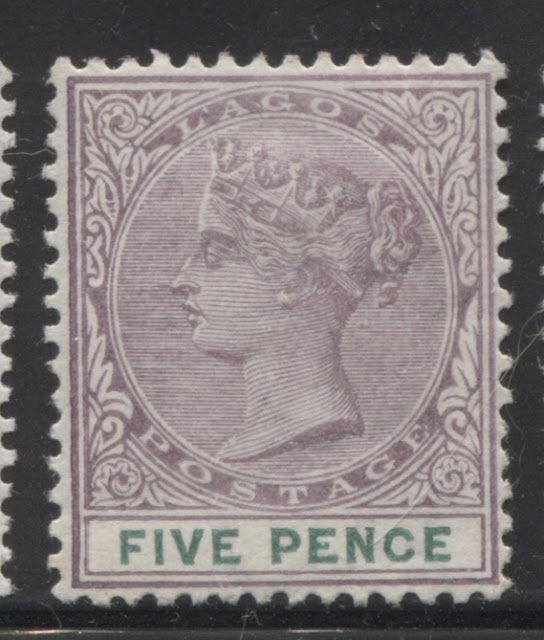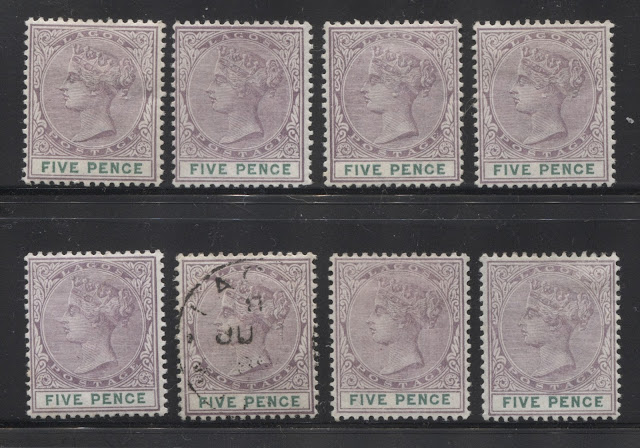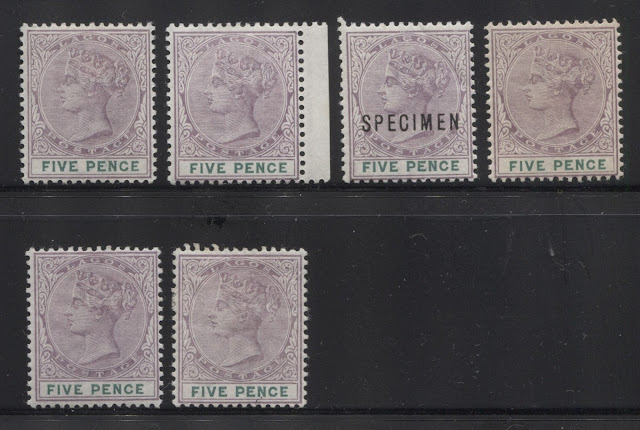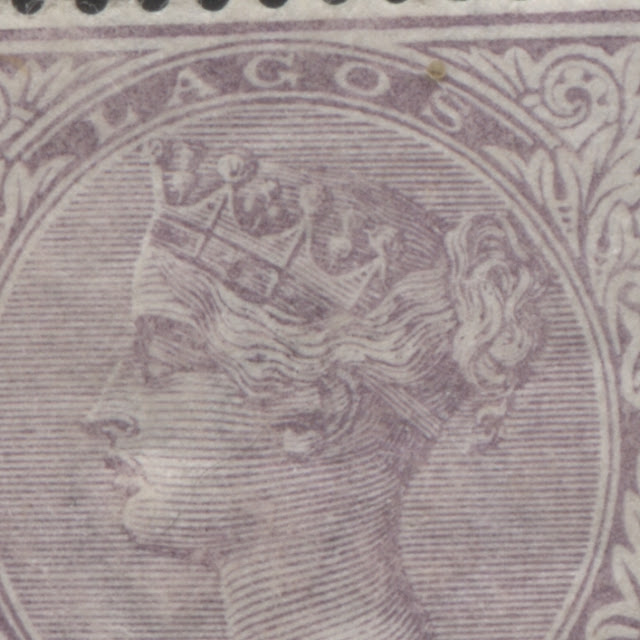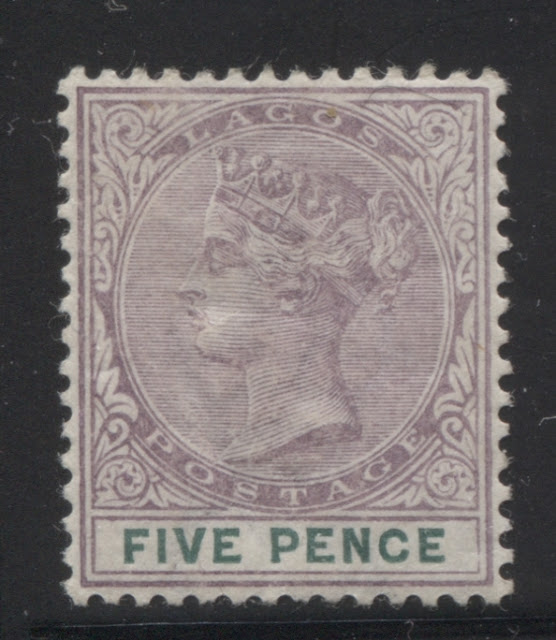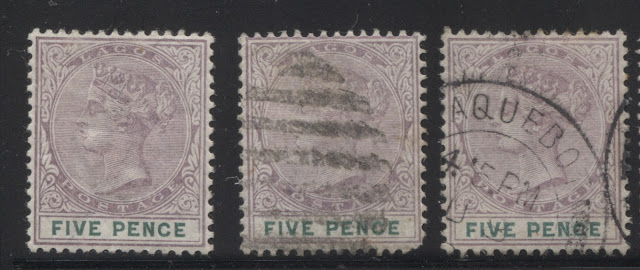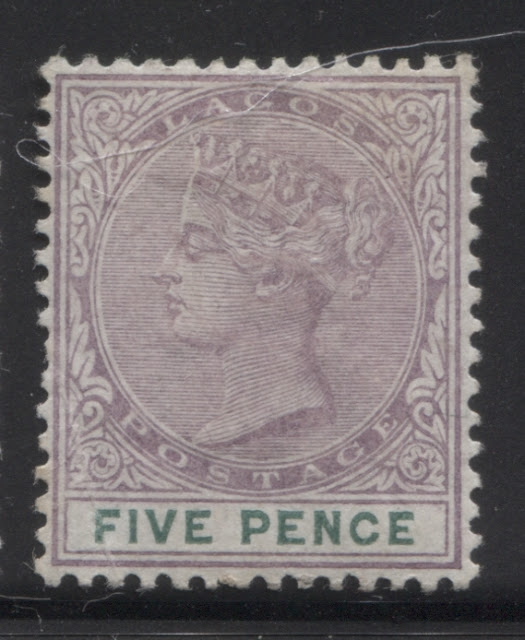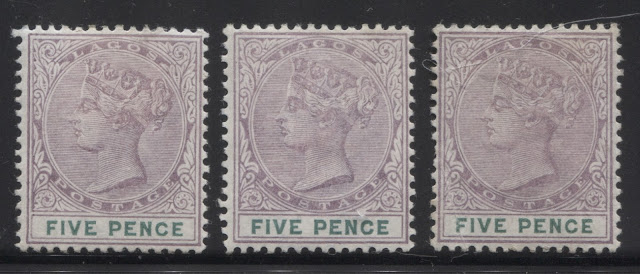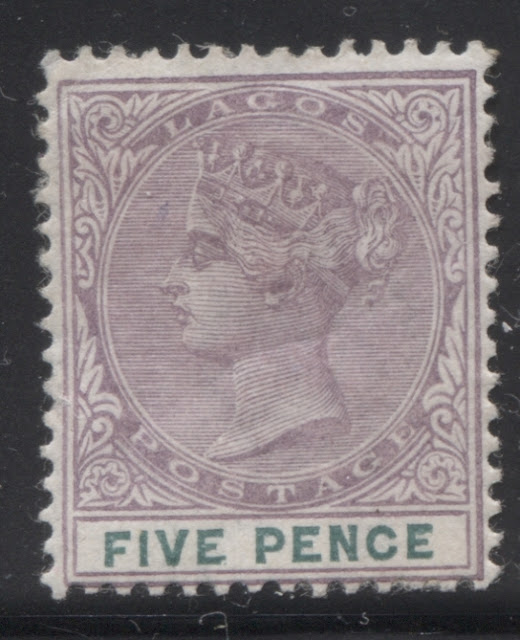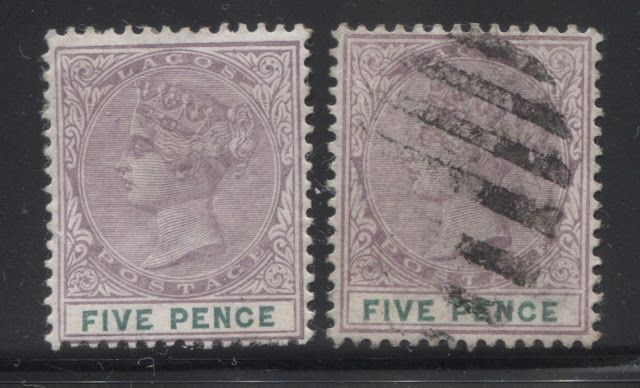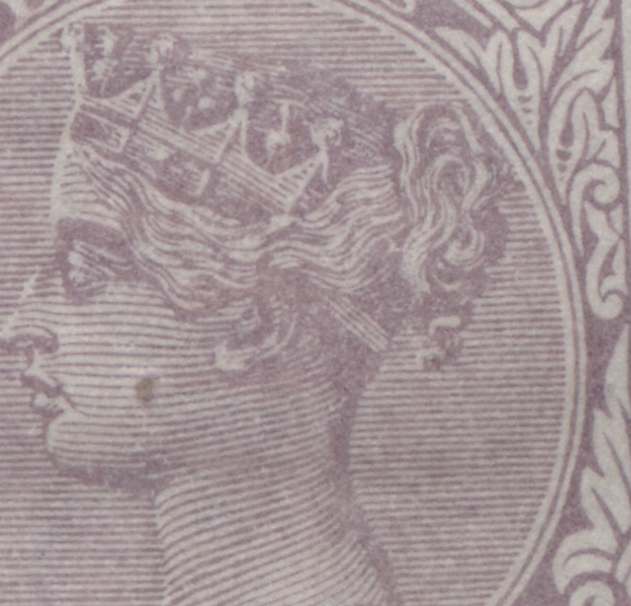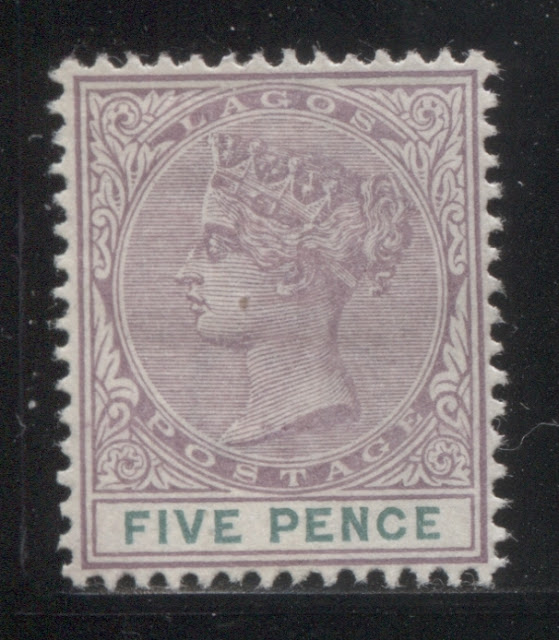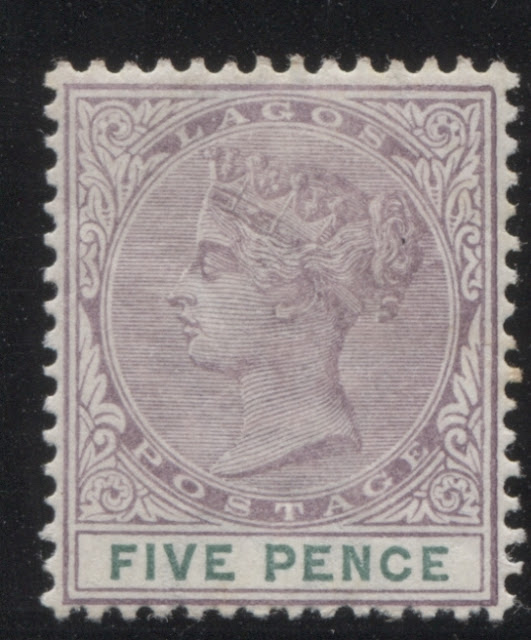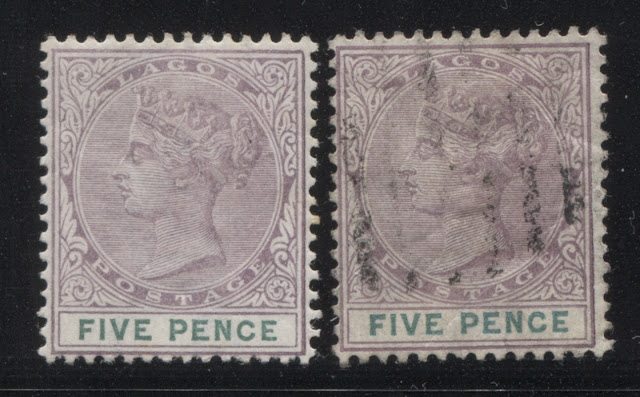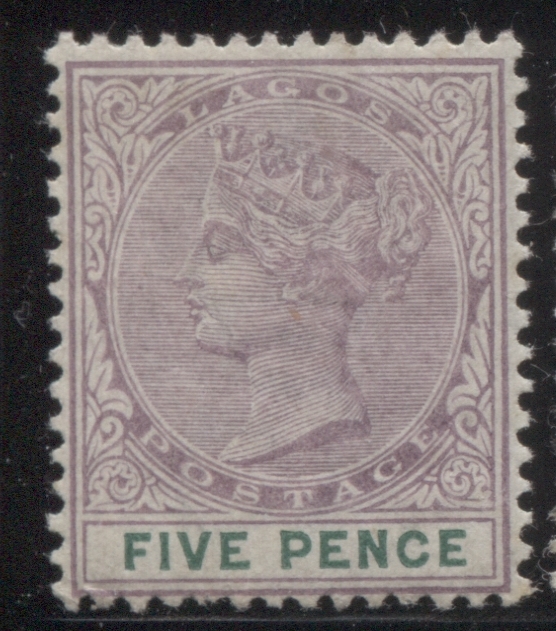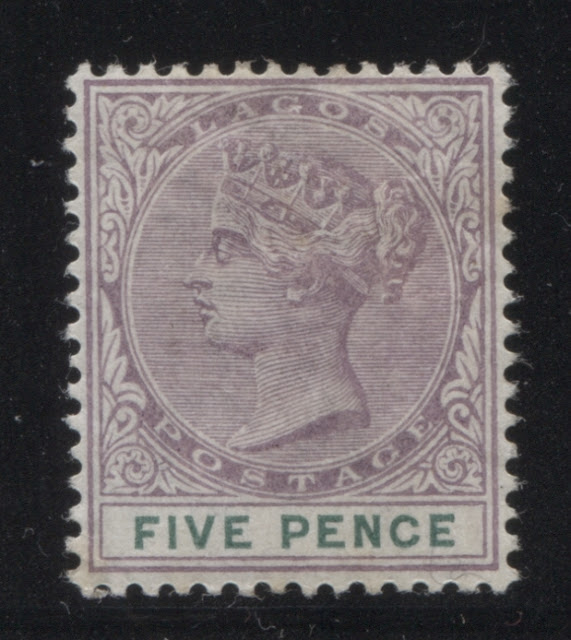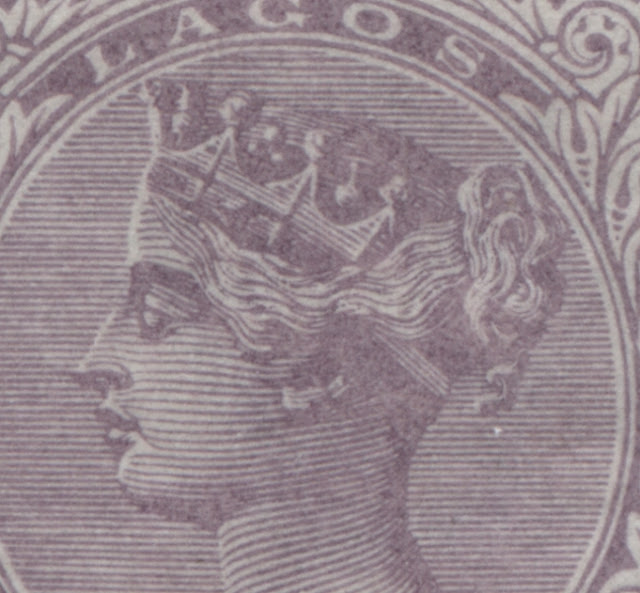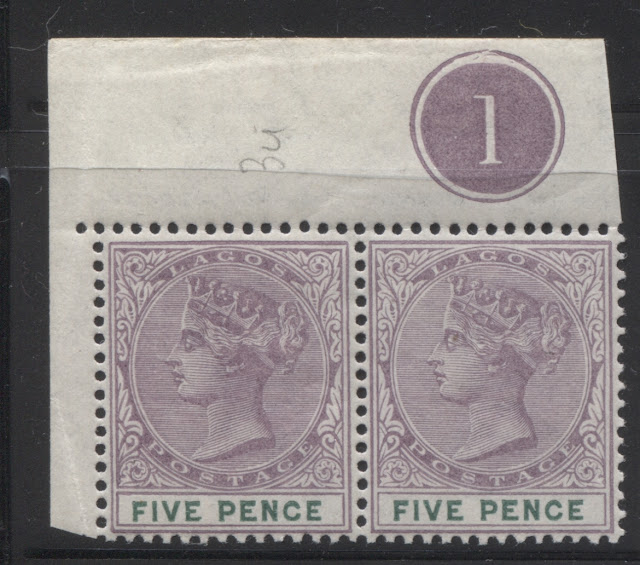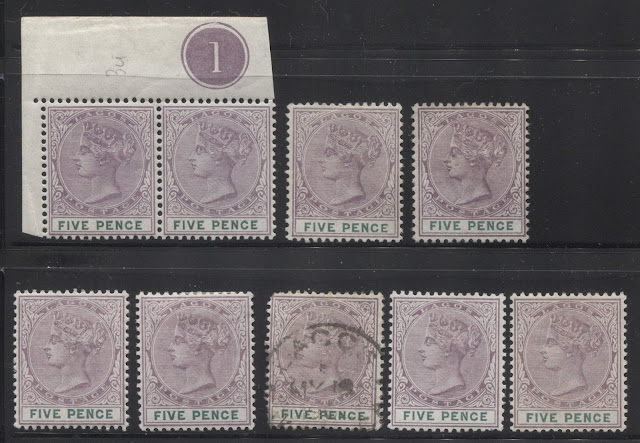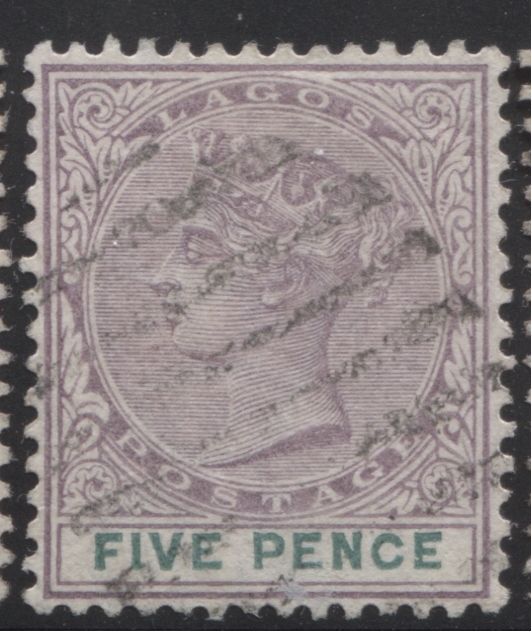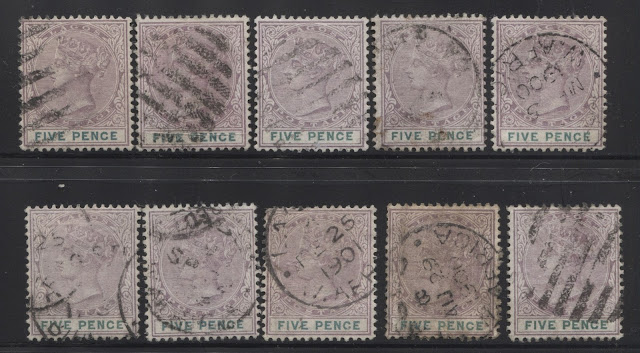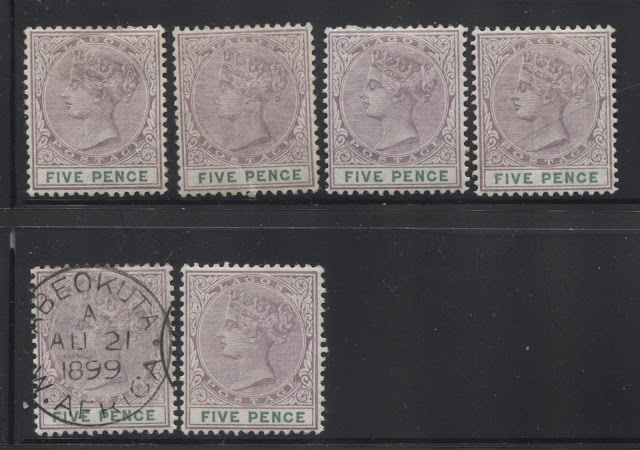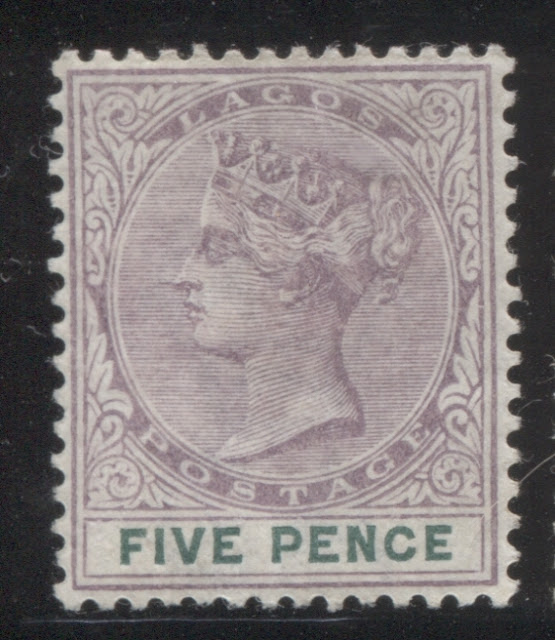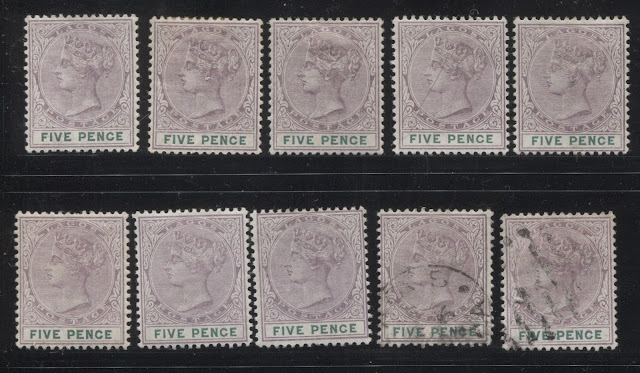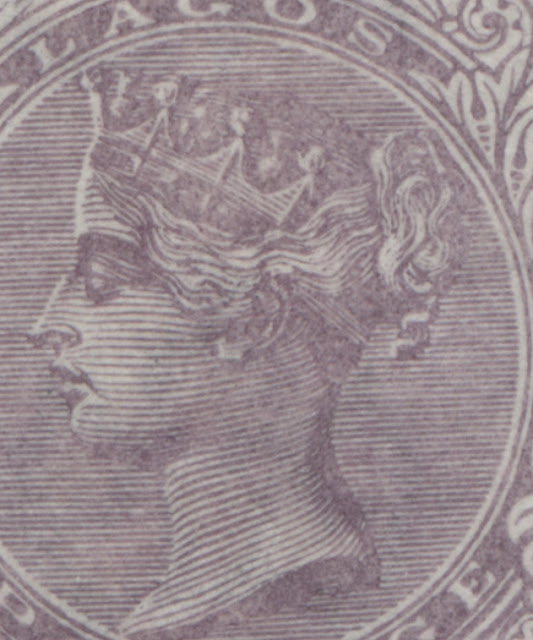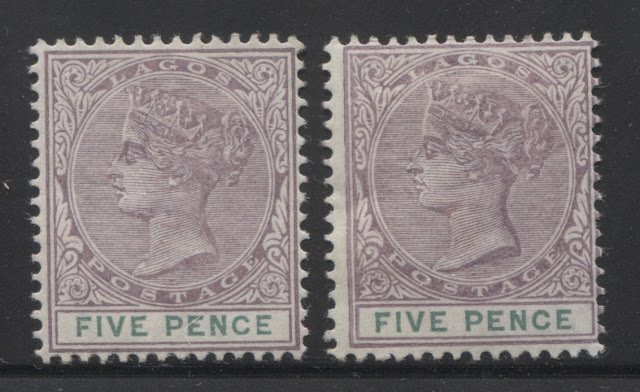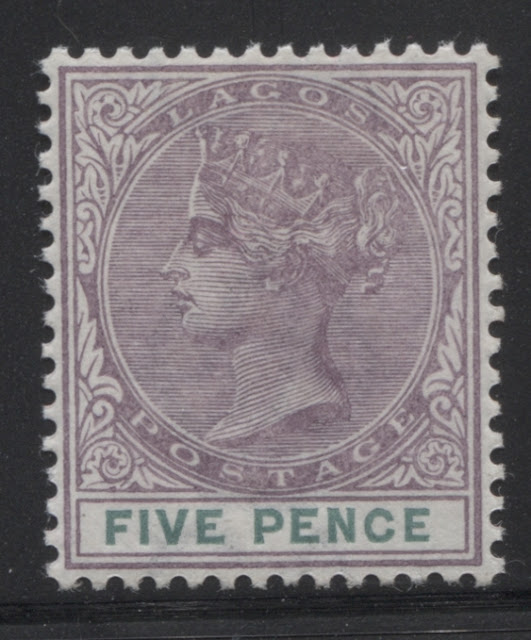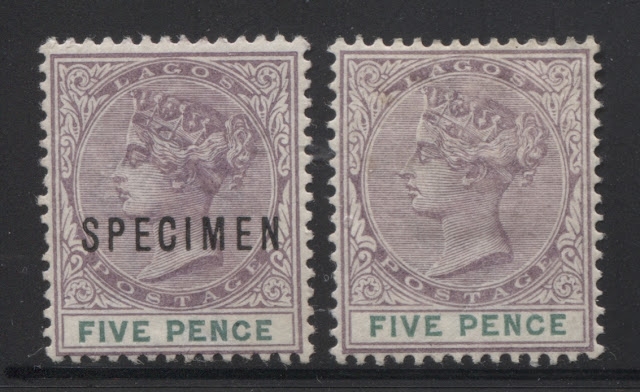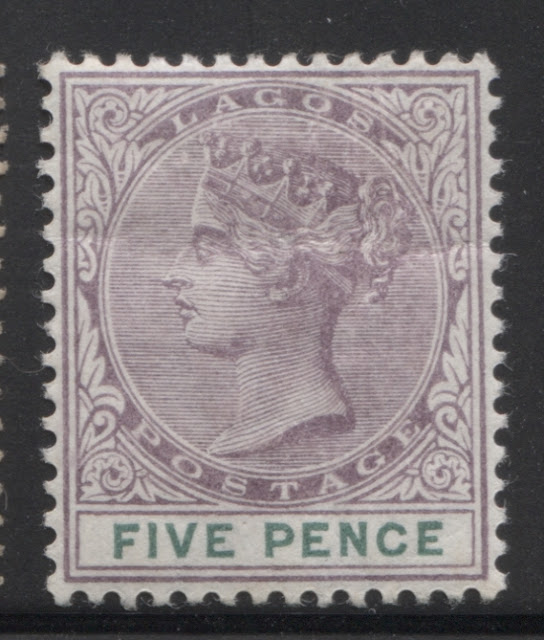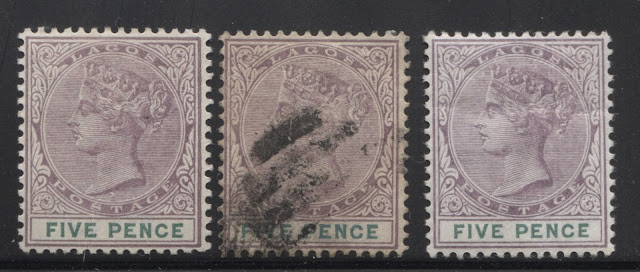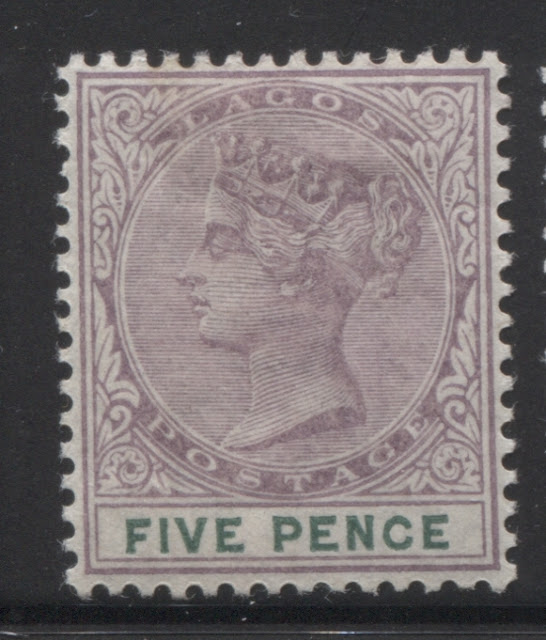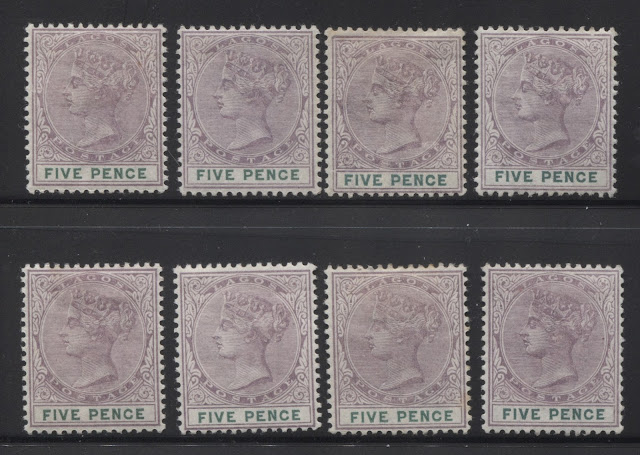Overview
The 5d lilac and dark green keyplate stamp of Lagos was one of three stamps that was first dispatched to the colony on December 30, 1893 and was issued to facilitate the payment of registration fees on parcels. The other two stamps were the 7.5d and the 10d. The 5d paid for indemnity up to 12 pounds, while the 7.5d paid up to 24 pounds and the 10d paid up to 36 pounds of value.
These three stamps should provide some important reference points to help us distinguish the printings of the other values, since they were in use for only a portion of the total period from 1887 to 1903. According to Ince, a total of 92,160 stamps were printed of the 5d, and 57,540 unsold remainders were destroyed in London. So the issue quantity was fairly limited, and suggests that there were probably nowhere near 4 printings per year that the stamp was current. The last shipment was August 19, 1901, which mde for a total period of use of 7 years and eight months. There were thus many fewer than 31 printings! How many there were is a question I will attempt to determine with this post. I am fortunate to have 93 mint and used singles as well as one mint block of 4 available for study. By looking carefully at the degree of plate wear, as indicated by the clarity of the hair and diadem, as discussed in my previous posts, in addition to the shades of the head and duty plates, I should be able to identify with a fair degree of accuracy how many printings there were, and approximately when many of them were made.
Preliminary Results
On my first sort of these stamps, I was able to separate them into six groups, with the sixth being stamps that were so heavily cancelled or rubbed as to not be useful as the true degree of plate wear could not be accurately assessed. The next step is to go through each of these groups and further sort them by shade and a more detailed assessment of the wear if warranted. It is also possible that this process will result in some reclassifications between printings, as it must be recognized that not every subject on the printing plate will have worn to the exact same degree. Therefore this method is really just a preliminary sort to begin breaking down the stamps into manageable groups.
After sorting for shades, which were very similar between the groups, I was able to organize the stamps into five groups, each of which had between 2 and 5 printings as follows:
The duty plate colour remains unchanged at deep blue green and the head plate colour is similar to the dull purple in Gibbons' colour key, but it is just a touch more reddish. Here are the three examples that I have in stock:
The duty plate colour is still deep blue green. The head plate colour has become more reddish again and is now closest to pure reddish lilac on the Gibbons' colour key. Here is the above stamp next to my only used example:
On this printing the duty plate colour reverts back to the deep blue green of the earlier printings. The head plate is dull purple, but is slightly deeper and more intense than on the earlier printings. The scan below shows the five examples of this printing that I currently have:
The 5d lilac and dark green keyplate stamp of Lagos was one of three stamps that was first dispatched to the colony on December 30, 1893 and was issued to facilitate the payment of registration fees on parcels. The other two stamps were the 7.5d and the 10d. The 5d paid for indemnity up to 12 pounds, while the 7.5d paid up to 24 pounds and the 10d paid up to 36 pounds of value.
These three stamps should provide some important reference points to help us distinguish the printings of the other values, since they were in use for only a portion of the total period from 1887 to 1903. According to Ince, a total of 92,160 stamps were printed of the 5d, and 57,540 unsold remainders were destroyed in London. So the issue quantity was fairly limited, and suggests that there were probably nowhere near 4 printings per year that the stamp was current. The last shipment was August 19, 1901, which mde for a total period of use of 7 years and eight months. There were thus many fewer than 31 printings! How many there were is a question I will attempt to determine with this post. I am fortunate to have 93 mint and used singles as well as one mint block of 4 available for study. By looking carefully at the degree of plate wear, as indicated by the clarity of the hair and diadem, as discussed in my previous posts, in addition to the shades of the head and duty plates, I should be able to identify with a fair degree of accuracy how many printings there were, and approximately when many of them were made.
Preliminary Results
On my first sort of these stamps, I was able to separate them into six groups, with the sixth being stamps that were so heavily cancelled or rubbed as to not be useful as the true degree of plate wear could not be accurately assessed. The next step is to go through each of these groups and further sort them by shade and a more detailed assessment of the wear if warranted. It is also possible that this process will result in some reclassifications between printings, as it must be recognized that not every subject on the printing plate will have worn to the exact same degree. Therefore this method is really just a preliminary sort to begin breaking down the stamps into manageable groups.
After sorting for shades, which were very similar between the groups, I was able to organize the stamps into five groups, each of which had between 2 and 5 printings as follows:
- Group 1, being the earliest printings appears to have two printings. I have only one dated used example. The date is not legible, but if I look very closely at the last numeral of the date, I can just make out the slope of "4". This is consistent with these printings being from 1894.
- Group 2, being the next most recent printings appears to have three printings. None of the six used examples from this group had dated cancellations. All were postmarked with what appear to be 8-bar oval obliterators.
- Group 3, consists of four different printings. Both used examples in this group come from the same printing, with one being dated August 29, 1895 and the other being dated April 13, 1897.
- Group 4 consists of four printings also. Most used examples in this group are dated between August 1899 and May 1902.
- Group 5 consists of five printings. Only one of these is used and it is cancelled with an 8-br obilterator. The lack of used examples is consistent with these being from the very last printings.
Thus there would appear to be 18 different printings, which is entirely plausible for the total number of stamps printed. Many of the shades in each of the groups are very close, if not indistinguishable from those in other groups. So it is possible that there may actually be fewer printings than this, but I think that the differences in plate wear with each group are significant enough to suggest their classification as different printings.
Lets now take a closer look at the stamps in each group. Unfortunately I do not have a sufficient number of dated used examples to positively date each printing, so my designations "first printing", "second printing" and so forth must be taken with a grain of salt.
Group 1 - Printings 1-2
The defining characteristic of the printings in this group is that the show the state of the plate in what I would call its intermediate state. In this state, nearly all of the detail in the hair above the crown is visible as separate Wavy lines. There is some merging of the first three lines at the very top of the hair, but all the other lines are visible. In addition, there is some detail remaining in the hair at the very back of the neck, both above and below the diagonal ribbon. We are also just beginning to see merging together of the fine horizontal shading lines located in the bottom band of the crown, in between each of the jewels.
First Printing
The head plate of this printing, which I actually believe is the true first printing, based on the single 1894 dated example, is a slightly paler version of the dull purple swatch on the Stanley Gibbons colour key. The duty plate colour is closest to Gibbons' deep blue green swatch.
Here is a group of all eight of the stamps from this printing that are currently in stock:
As you can see the colours are uniform throughout the group. The cancel on the single used stamp is difficult to read, but with care you can just make out the "4" in "1894. So the cancel is from June 1894 - six months after the first shipment was sent.
Second Printing
The head plate colour of this second printing is similar to the first except that it is both paler and redder. It is actually closest to the reddish lilac swatch on the Gibbons colour key. The only difference is that the colour is a bit duller than that swatch on the key. The green colour of the duty plate is identical to the first printing, being a deep blue green.
Here is a scan showing all six examples in my stock:
I had originally assumed that any example with a specimen overprint had to be from the first printing because I had envisioned that any distribution of stamps to member countries of the UPU would be done only when the stamps were first issued. However, I have seen examples from later printings with specimen overprints also, which leads me to believe that they were also given out for other reasons as well and could come from any printing. However, it is possible that this group is actually the first printing, while the first group above is actually the second printing.
Group 2 - Printings 3 -5
On this group of printings, we begin to see very slight merging of other lines of the hair at the top of the head. If you look at the crown, you will see that there are four large round jewels at the tips, and i between those are two thistles and a shamrock. Dividing the hair lines into those around the rear thistle and the shamrock, or above those two ornaments provides a useful way of describing how the plate wear affects the hair. On this group of printings we see slight merging of the lowest two or three hairlines that are located around the shamrock and the rear thistle. The lines above these ornaments are still clearly defined, and there is still detail visible in the hair at the back of the neck, both above and below the diagonal ribbon.
Third Printing
The duty plate colour of this printing has not changed, and is still deep blue green. The head plate colour contains just the slightest hint of brown, being closest to dull purple on the Gibbons colour key.
These are three of the six examples currently in my stock. All four of the used examples are cancelled with 8-bar oval killers.
Fourth Printing
The duty plate colour remains unchanged at deep blue green and the head plate colour is similar to the dull purple in Gibbons' colour key, but it is just a touch more reddish. Here are the three examples that I have in stock:
Fifth Printing
The duty plate colour is still deep blue green. The head plate colour has become more reddish again and is now closest to pure reddish lilac on the Gibbons' colour key. Here is the above stamp next to my only used example:
Group 3 - Printings 6 Through 9
In this group of printings, the hair at the back of the neck below the diagonal ribbon is almost a solid mass of colour with almost no white detail visible at all. There is still a small amount of detail visible in the hair above the ribbon, but it too is very close now to becoming a solid mass of colour. The lowest two or three hairlines that are surrounding the shamrock in the crown are almost completely fused together on these printings and the hair lines surrounding the rear thistle are almost totally one solid mass as well, with some detail generally only visible to the left of this shamrock, but occasionally on the right of it as well. Most of the horizontal shading lines in the lower band of the crown are still visible, though they are still beginning to merge together.
Sixth Printing
The green of the duty plate of this printing for the first time is paler, and without the bluish undertone, being closest to plain deep green. The head plate colour is a dull purple that is quite pale by comparison to the other dull purple shades.
Seventh Printing
The head plate of this printing is dull purple on Gibbons' colour key, while the duty plate is deep blue green. Here is a side by side scan of the above stamp with the only used example that I have.
Eighth Printing
The head plate colour of this printing dull purple, as was the case with the sixth printing. However, the green of the duty plate is darker, and with more of a bluish undertone. In fact it is closest to the deep bluish green swatch on the Gibbons colour key, not to be confused with deep blue green, which appears slightly brighter and less bluish.
The scan below shows the four examples that are currently in my stock, with two of them being used between August 29, 1895 and April 13, 1897.
Ninth Printing
On this printing the duty plate colour reverts back to the deep blue green of the earlier printings. The head plate is dull purple, but is slightly deeper and more intense than on the earlier printings. The scan below shows the five examples of this printing that I currently have:
Group 4 - Printings 10 Through 13
On these printings, the merging of the hairlines at the top of the Queen's hair have advanced so that now instead of the top two to three hairlines being merged together it is now the top four or five. The hair behind the very last jewel of the crown has largely merged together. The hairlines surrounding the shamrock up to about half way up the shamrock have almost completely merged together. There is now only a narrow band of hair on top of the head that shows all the detail. Several of the fine horizontal shading lines in the lower band of the crown have now merged together.
Tenth Printing
On this printing, the duty plate colour is the deepest pure green shade that is on the Gibbons colour key, which is Myrtle green. The head plate colour is closest to reddish lilac on the Gibbons colour key, but is quite a bit deeper.
The scan below shows all ten examples in my stock. Unfortunately the cancellation date on the one used single I have is not readable, so that I cannot date this printing.
Eleventh Printing
This printing is most distinct in the sense that the duty plate green is the most bluish green imaginable. It is closest to the deep turquiose green swatch on the Gibbons colour key, but I would say that it is actually a little bit darker. However it has the same strong bluish undertone. The head plate colour is closest to grey lilac on the colour key, but is a little more reddish.
Here are all ten used examples that are currently in my stock. Interestingly, I do not possess any mint examples:
These are mostly dated between 1900 and 1901. However, given that there are still at least another five printings after this one made before August 1901, I would think it highly unlikely that this printing was made after 1898 or 1899. I think that most of these were simply used 2-3 years after being made available for sale.
Twelfth Printing
The duty plate colour of this printing is a deep green with no bluish undertone, closest to deep green on the Gibbons colour key. The head plate colour is closest to dull purple.
The scan below shows the six stamps I have in stock. The single used example is cancelled in August of 1899, so it is likely a printing made either in 1898 or 1899.
Thirteenth Printing
The duty plate colour of this printing reverts back to the deep bluish green shade. The head plate is a reddish grey-lilac in that it matches neither the reddish lilac or the grey-lilac swatches on the gibbons colour key. It is close to both, but with either rose added in the case of the grey-lilac swatch, or grey added in the case of the reddish lilac swatch.
I currently have eight mint and two used examples in my stock, though unfortunately neither of the two used examples show a readable date:Group 5 - Printings 14 Through 18
In this group of printings most all of the finer detail in the lower band of the crown and the hair bove the crown is gone. The hair at the back of the neck, both above and below the ribbon is one sold mass of color, with only the tiniest amount of white visible.
Fourteenth Printing
In this printing the duty plate colour is closest to blue green on the Gibbons colour key. It is quite a dull colour by comparison to the other shades. The head plate colour is a pure dull purple.
Fifteenth Printing
I have only one solitary example of this printing. On this printing, the duty plate colour loses the bluish undertone, being closest to the pure deep green swatch. The head plate colour is a deep dull purple.
Sixteenth Printing
On this printing the duty plate colour once again is closest to deep green and the head plate colour is closest to dull purple. However, the purple contains the slightest hint of blue to the tone.
Seventeenth Printing
The duty plate colour of this printing moves away from pure deep green and takes on a slight bluish tone, being deep blue green. The head plate colour is closest to dull purple on the Gibbons colour key.
The scan below shows the three examples that I have in stock, with the middle stamp being my only used example from this entire group.
Eighteenth Printing
The duty plate colour of this last printing is the deepest blue green which is called deep bluish green on the Gibbons colour key. The head plate colour is closest to grey-lilac, being just a little more reddish than the swatch.
I have eight mint examples of this printing, all shown below:
From the almost complete lack of used examples, it would appear that very few of the stamps from the printings in group 5 were ever used. There were 57,540 unsold remainders according to Ince, that were destroyed after 1903. This represents more than half of the total printing. So it would seem that very few of the stamps sent with the last five shipments of stamps that were sent to the colony were ever used.
Preliminary Conclusions
Although I do not have a sufficient number of dated used examples to precisely date each of the potential printings I have identified, I can assign each of the groups to approximate date ranges based on the cancellations seen and other information gleaned from the stamps as follows:
- Group one stamps would appear to be from early to mid 1894.
- Group two stamps would seem to be from late 1894 to mid 1895.
- Group three stamps would seem to be from mid 1895 to about the end of 1897.
- Group four stamps would appear to cover the period from, 1898 to the end of 1899.
- Group five stamps would appear to cover the period from 1900 to the the last shipment in August 1901.
This concludes my examination and discussion of the 5d lilac and green Queen Victoria Keyplate stamp of Lagos. In the coming weeks, I will repeat the process for the 7.5d and 10d stamps. This should help provide a solid reference point, which I can then build from when the time comes to look at the 3d and 2.5d values, which were first issued in late 1890 and 1891.



